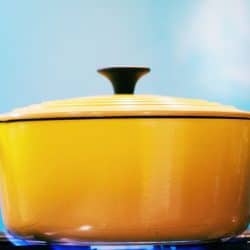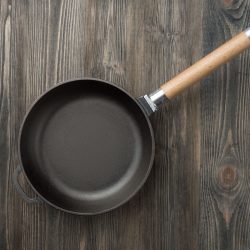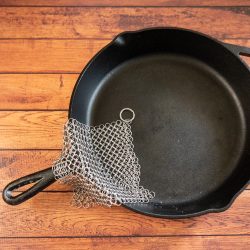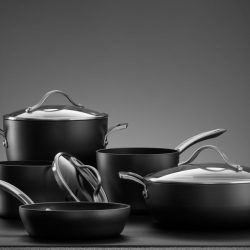If you are in search of a new stock pot, the odds are that you already know how often this versatile piece of cookware is used in domestic kitchens. You might be wondering what the best material for a stock pot is? We have researched the pros and cons of stock pot materials to get the answer for you.
The best material for a stock pot is food-grade stainless steel because it is durable, non-reactive, non-stick, and affordable.
Keep reading, and we will delve into why stainless steel is a popular choice for cookware. We will also give you a brief breakdown of the pros and cons of other stock pot materials so that you can make the right choice for your kitchen.
![Stock pot over a glass ceramic kitchen, What’s the Best Material for Stock Pots? [Know before you buy!]](https://kitchenseer.com/wp-content/uploads/2020/07/What’s-the-Best-Material-for-Stock-Pots.jpg)
What Materials are Stock Pots Made From?
You will have a wide selection of materials to choose from when selecting a stock pot, such as:
- Stainless steel.
- Aluminum.
- Copper.
- Carbon steel with enamel finish.
- Cast iron with enamel finish.
Stainless Steel Stock Pots
Food-grade stainless steel is a die-hard material widely used for kitchenware, including pots and pans. It is popular among domestic and professional cooks alike because it is durable, easy to clean, and resistant to corrosion. Stainless steel is affordable, so you can select any size stock pot fabricated from stainless steel without breaking the bank.
Click here to find this 12-quart stainless steel stock pot by Cooks Standard on Amazon.
Aluminum Stock Pots
Aluminum is a lightweight, soft metal; it is durable in terms of longevity, yet because it is a soft metal, it is prone to scratches and staining. Aluminum is an extremely efficient heat conductor, which gives it the advantage when used for stock pots. Aluminum tends to be slightly cheaper than stainless steel, so if you are in search of a larger stock pot, it might be a good choice.
Click here to find this 8-quart stock pot by Winco USA on Amazon.
However, aluminum is a reactive metal - meaning that aluminum can alter the flavor of foods, especially acidic foods like citrus, foods containing eggs, and alkaline foods. To reduce the reactivity, select an aluminum stock pot either coated with enamel or fabricated using anodized aluminum. Both coated and anodized aluminum pots are relatively non-stick, less prone to scratch or discolor, and easy to clean.
Copper Stock Pots
Copper is an incredibly durable, lightweight metal that is an excellent conductor of heat. A reactive metal, professional chefs use copper bowls to their advantage for whipping egg whites for a super fluffy consistency. Used for stock pots, copper might cost a pretty penny, but it will provide a timeless piece of cookware both in function and quality.
Click here to find this 7-quart copper stock pot by Concord Cookware on Amazon.
Many copper stock pots have a non-stick coating for extra ease of cooking and cleaning. For a classy look, choose a copper pot with a hammered exterior finish.
Carbon Steel Stock Pots with Enamel Finish
Carbon steel is lightweight and durable, very similar to stainless steel. This metal is a fair conductor of heat. But, carbon steel is a reactive metal, which means it can alter the flavor of your foods. Carbon steel stock pots must either be seasoned or coated with enamel to reduce reactivity. Both seasoning and enamel also add non-stick properties to the pan. Easy to clean, enameled carbon steel can add a burst of color to your kitchen for slightly less the cost of a stainless steel pot.
Click here to find this 8-quart carbon steel, enameled stock pot by Le Creuset on Amazon.
Cast Iron Stock Pots with Enamel Finish
Enameled cast iron adds a colorful, yet functional piece of cookware to your kitchen. Cast iron is ideal for slow-cooking because it retains heat evenly throughout. But, cast iron is hefty and tends to be a more expensive material for stock pots. An enameled finish makes cast iron non-reactive and easy to clean. If you are interested in a cast iron stock pot, you might also consider a Dutch oven because it can be used either on the stovetop or in the oven.
Click here to find this 6-quart cast iron, enameled stock pot by Lodge on Amazon.
If you are wondering how the type of material affects the other cookware in your kitchen, check out our blog “9 Types of Mixing Bowls You Should Know,” for all the details on what types of bowls to use for preparing and serving different foods.
What Are the Benefits of Stainless Steel Stock Pots?
So, why is stainless steel the most popular choice of material for a stock pot? Let’s take a look at the properties that make stainless steel the best choice for domestic kitchens.
Heat Conductivity
Stainless steel is not the best conductor of heat, but it does retain heat well and distribute heat evenly across the surface.
If you want to increase the conductivity of a stainless steel stock pot, select a pot with an encapsulated base containing either aluminum or copper. The base construction of layered metals or tri-ply uses the highly conductive metal inside to heat the pot faster; meanwhile, the stainless steel conducts heat throughout the sides of the cookware.
Non-Reactive Metal
Food-grade stainless steel is non-reactive, so it will not alter the flavors of your foods. You can cook and store foods in stainless steel pots or containers without the worry that trace amounts of metal will leech into the food.
Because it is non-reactive, stainless steel is also resistant to scratches and stains. So when you purchase your stainless steel stock pot, you can rest assured it will retain the same brilliant finish throughout the life of the pot.
Choose Your Finish
Polished stainless steel gives stock pots a gleaming exterior finish, so you can admire the shine from the stovetop while you cook.
But, for those who prefer less showy cookware, you can get all of the benefits of stainless steel with a brushed (or matte) exterior finish for a more subdued look.
Click here to find this 4-quart, brushed stainless stock pot by All Clad on Amazon.
Non-stick Surfaces
Inside and out, stainless steel stock pots are non-stick without any need for pre-seasoning or coating with enamel. No more worries about a burnt-on mess, because non-stick stainless makes cooking and cleaning a breeze.
Now that you know that stainless steel is the best material for stock pots, get one the right size for your kitchen. Check out our blog, “How Big of a Stock Pot Do I Need?” to get all the details on how to measure stock pots, the many uses of stock pots, and how to get the right size for your recipes and serving yield.












